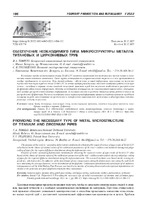Обеспечение необходимого типа микроструктуры металла титановых и циркониевых труб

Date
2022Publisher
Another Title
Providing the necessary type of metal microstructure of titanium and zirconium pipes
Bibliographic entry
Томило, В. А. Обеспечение необходимого типа микроструктуры металла титановых и циркониевых труб = Providing the necessary type of metal microstructure of titanium and zirconium pipes / В. А. Томило, С. В. Пилипенко // Литье и металлургия. – 2022. – № 1. – С. 106-112.
Abstract
Бесшовные трубы из титанового сплава Ti‑3Al‑2.5V являются заготовкой для изготовления частей машин и механизмов ответственного назначения. Такие трубы используются в аэрокосмической отрасли и к ним предъявляются особые требования к их качеству. Цель данной работы – обеспечение условий деформации, нацеленных на получение требуемой текстуры труб из сплава Ti‑3Al‑2,5V, на основе выбора рациональных значений калибровки рабочего инструмента – калибров и оправок стана холодной пильгерной прокатки труб для получения необходимого распределения Q-фактора вдоль конуса деформации. Методы исследования основывались на существующей зависимости, описывающей влияние распределения истинных деформаций, по толщине стенки и среднему диаметру вдоль рабочего конуса на распределение Q-фактора. Расчеты калибровки и всех параметров деформации процесса холодной прокатки труб были основаны на ряде существующих теоретических и эмпирических зависимостей, включенных в общепринятые адаптированные методы их расчета.
Abstract in another language
The purpose of this work is – providing deformation conditions for obtaining the required texture of pipes made of Ti‑3Al‑2.5V alloy based on the choice of rational values of the calibration parameters of the t ool – calibers and mandrels during cold pilger rolling of pipes for the required Q-factor distribution along the deformation cone. Purpose of work – providing deformation conditions for obtaining the required texture of pipes made of Ti‑3Al‑2.5V alloy based on the choice of rational values of the calibration parameters of the tool – calibers and mandrels during cold pilger rolling of pipes for the required Q-factor distribution along the deformation cone. The research methods were based on the existing dependence, which describes the influence of the distribution of true compressions along the deformation cone along the wall thickness and along the average diameter, on the distribution of the Q-factor. Calibration calculation and calculation of all deformation parameters of the Cold Rolling Pipe Process was based on a number of existing theoretical and empirical dependencies included in the generally accepted adapted methods for their calculation.
View/
Collections
- № 1[25]
